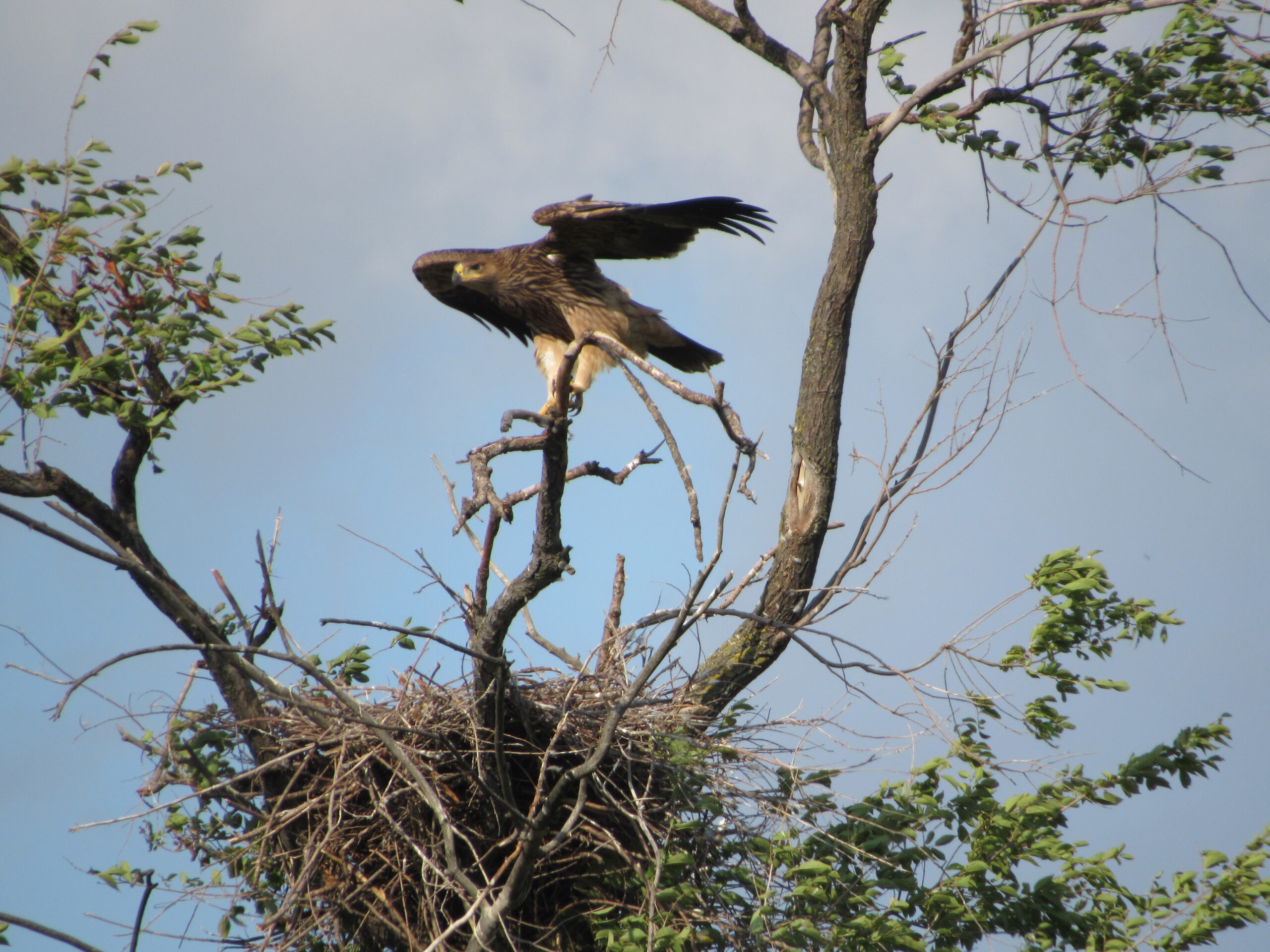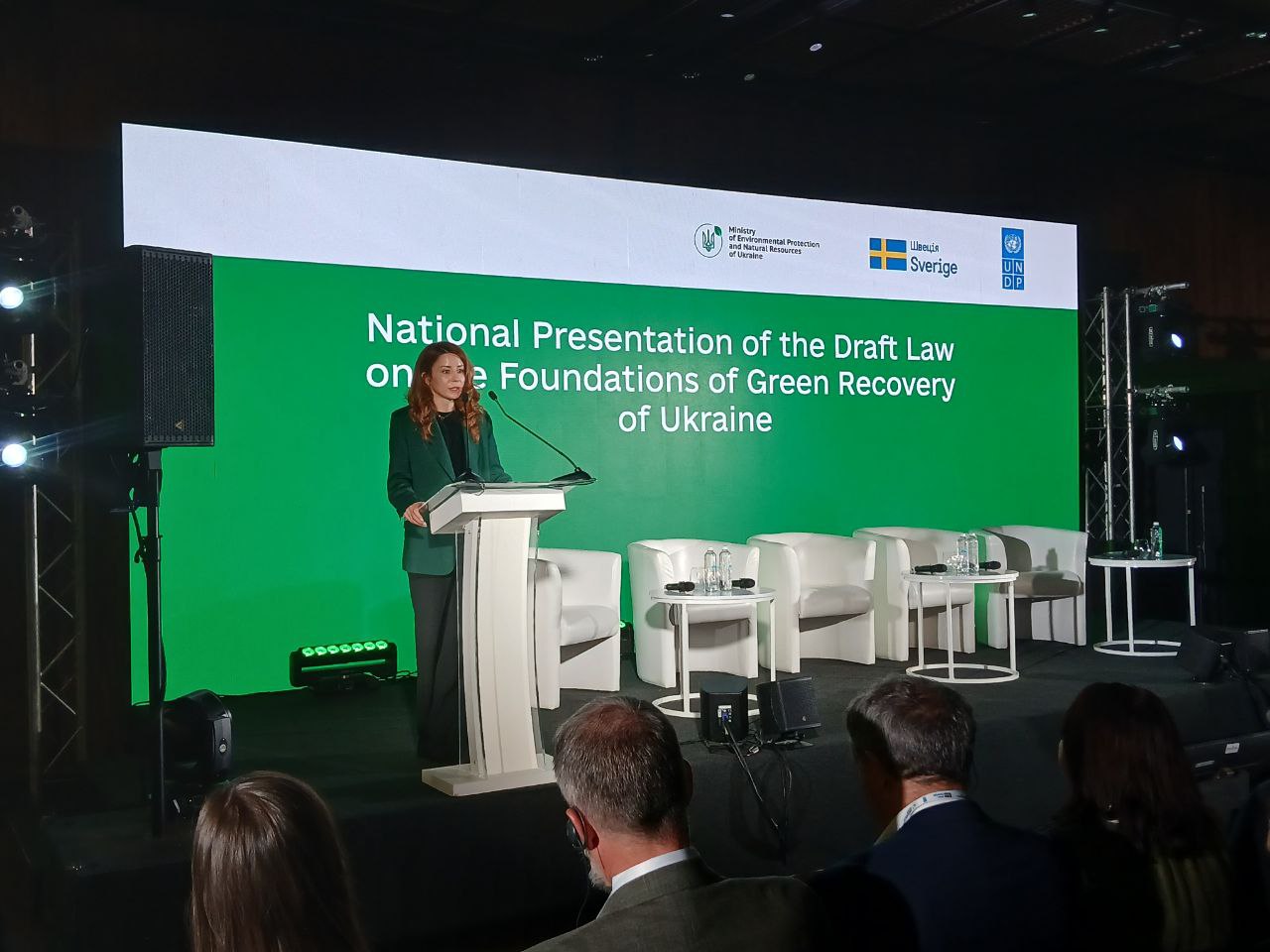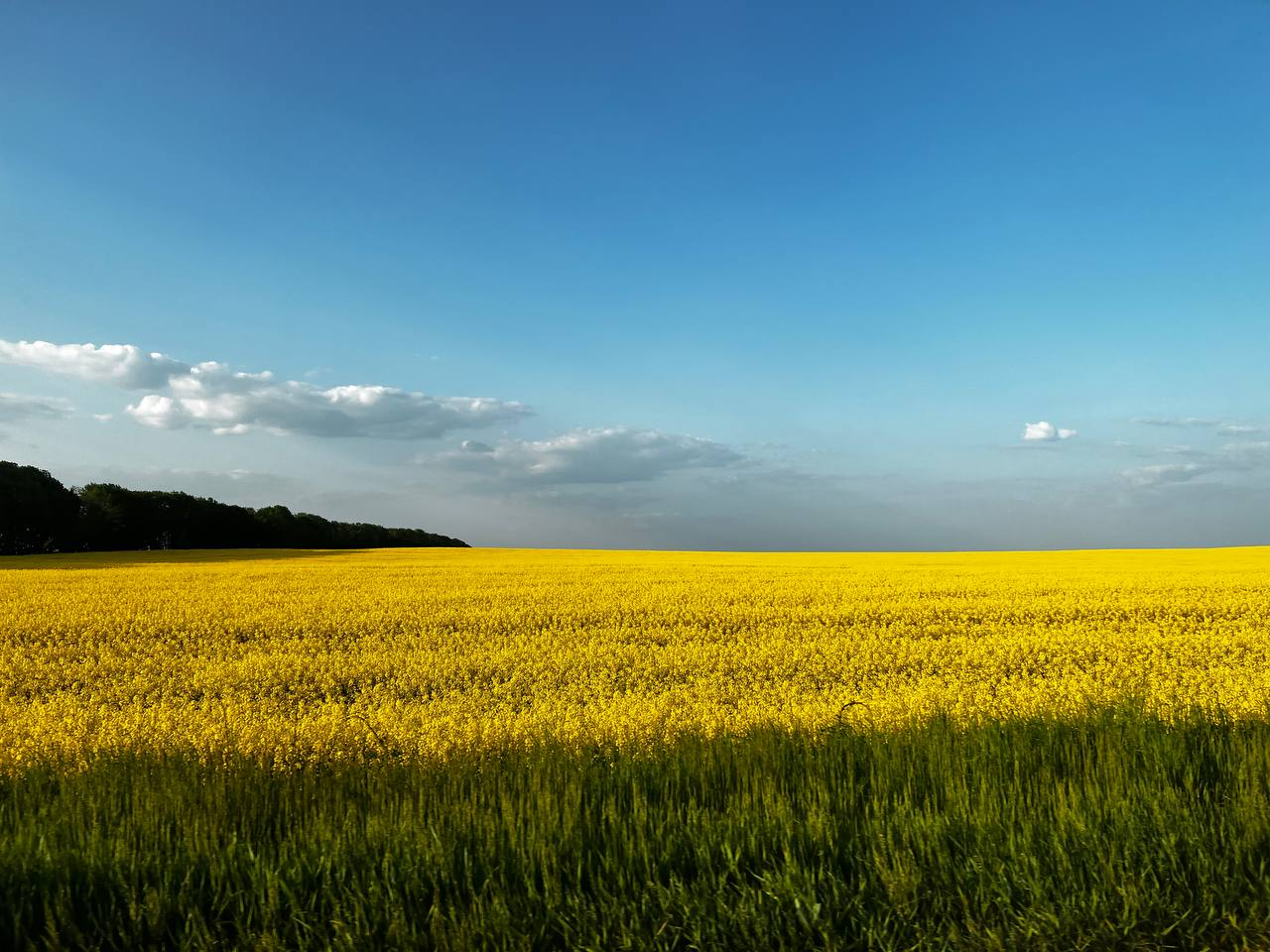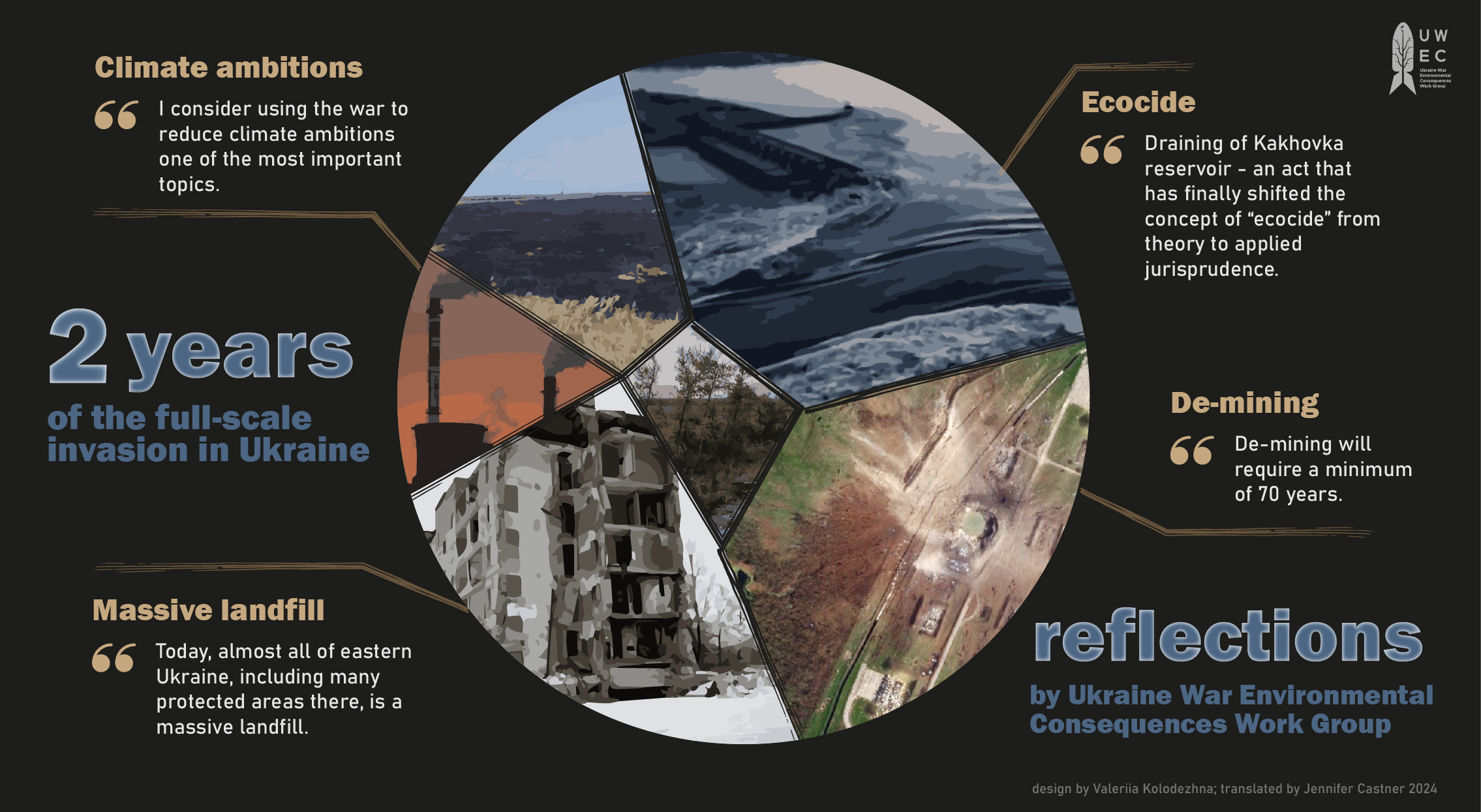Stanislav Viter
Recent research by the International Center for Ukrainian Victory shows that around 19.3% of all arable land in Ukraine — about 5 million hectares — is currently unused due to military action, occupation, or landmines. What are the economic and environmental impacts of the reduction of agricultural activity for Ukraine’s ecosystems, and what are the effects on biodiversity? We examine the prospects for restoring abandoned agricultural land to arable use, and explore how rewilding could help endangered steppe ecosystems to recover.
In 2022, for the first time in almost 80 years, large areas of agricultural land in the east and north of Ukraine’s Kharkiv region, as well as in some parts of the Kherson and Zaporizhzhia regions, lay untended. Gone was the quiet, even rumble of tractors — now replaced by the roar of artillery — while deep in occupied territory silence reigned, broken occasionally only by the song of a lark.
Extensive tracts of agricultural land were occupied by Russian troops in the first few weeks of the invasion, ending up deep behind the frontlines. Other sectors were the scene of intense fighting, leading to the contamination of soil with chemicals, unexploded ordnance and mines, while large agricultural areas along the frontlines were heavily mined. But whatever the cause, the result was the same: these regions became inaccessible to farmers and gradually became choked with grass.
The winter crops that had been sown in the fields before the invasion resembled the low-grass steppe that larks love so much, meaning that these birds, like partridges and quails, were in abundance. The ripe grains of winter crops fell onto the ground unharvested, providing mice with an unusually rich banquet and leading to an explosion in their numbers between the fall of 2022 and early 2023. This was witnessed by soldiers, whose dugouts and trenches were overrun with rodents from abandoned fields, as well as the small predators which feed on them: weasels, ermines, ferrets, and sometimes even snakes. The large number of rodents attracted birds of prey, and the absence of people in these large areas of agricultural land provided peace and quiet for nesting birds of prey that are very vulnerable to human disturbance — the mere presence of humans in nesting areas alone can disrupt breeding activity.
Read more: Military fortifications in Ukraine — what comes next?
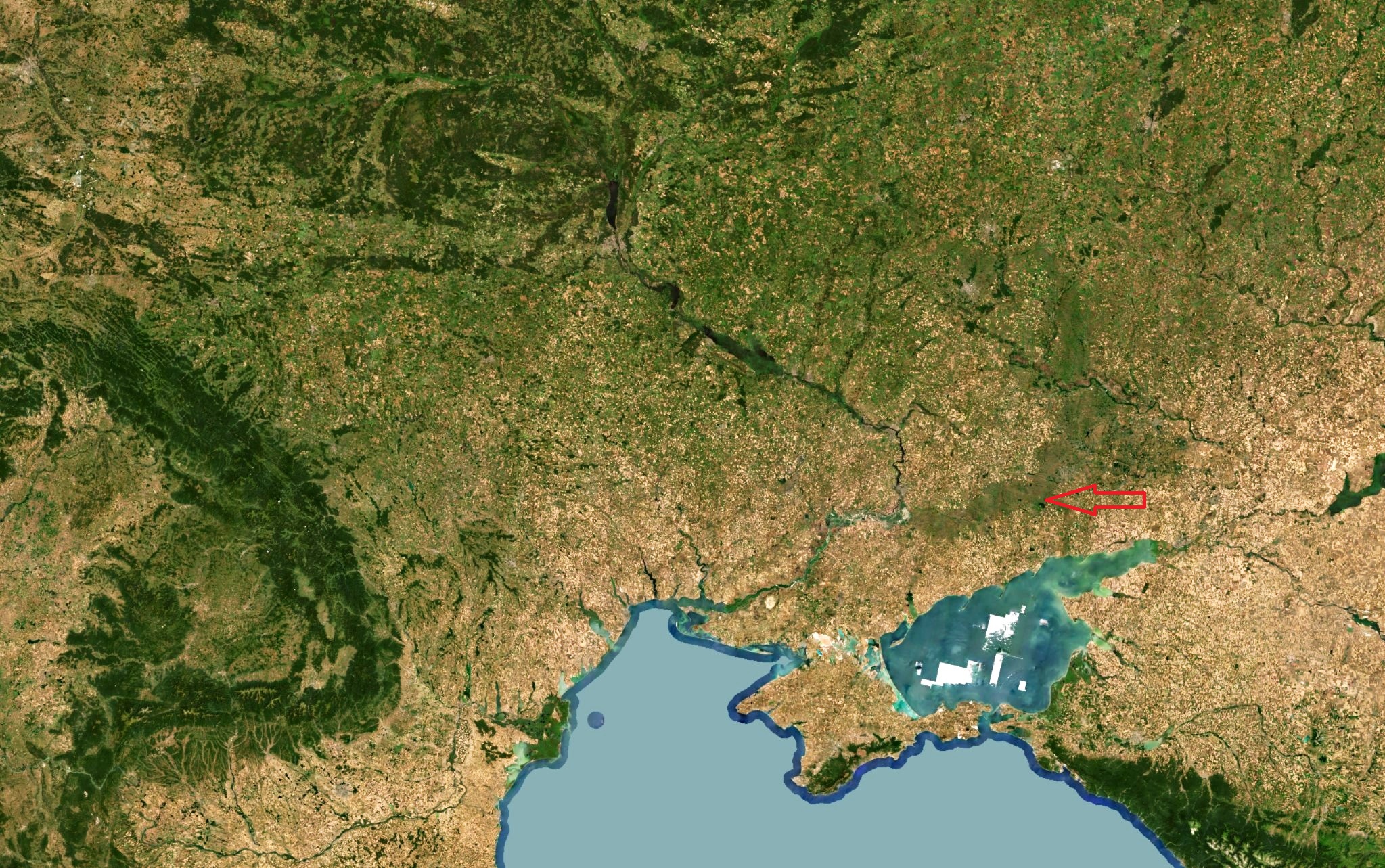

A heavy loss for agriculture
Agricultural landscapes occupy a large percentage of territory in Ukraine, accounting for 67.7% of the entire country. But they do not consist solely of farmland: they also feature relatively small landscape units within the boundaries of such territories that are not directly used to obtain agricultural products. These include elements such as treelines, roadsides, slopes that are inconvenient for cultivation, ponds and small river valleys. As of 2021, arable farmland occupied 56.8% of Ukraine’s territory, covering up to 70-90% of regions in the south and east — the areas that are today suffering the most from hostilities. And the arable land in eastern and southern regions of Ukraine contains a greater share of especially valuable fertile soils than anywhere else in the country.
The loss of these lands has had a noticeable impact on the country’s agricultural sector. A significant part of Ukraine’s grain and oilseed crops is grown in these areas, including almost its entire production of durum wheat. Steppe and meadow areas are used as grazing pastures for beef cattle and most of Ukraine’s sheep. So it is understandable that farmers will be keen to return these sought-after agricultural lands to intensive use if Kyiv can regain control of the eastern and southern regions.
Not all agricultural lands are completely artificial landscapes. Pastures and hayfields resemble natural grass ecosystems, which are actually the last natural areas of steppes and meadows in Ukraine, and provide a rich diversity of flora and fauna. It is hard to overestimate the importance of such territories, because it is these hayfields and pastures that provide a home for the rarest insect species in the steppe zone, while rare mammals such as ground squirrels, marmots and jerboas inhabit the numerous gullies. Most of these areas do not yet have protected status and their constant use as pastures and hayfields ensures the preservation of such populations.
Biodiversity on the back foot
As the full-scale war entered its second year the picture began to change, and not for the better. The biodiversity of agricultural landscapes began to suffer as winter crop seeds were eaten by mice or rotted, and new shoots were quickly smothered by invasive species. These are the first plants to colonize “free” areas of land such as wasteland, which is what the fields were essentially becoming. Mouse numbers now fell off substantially as a result of disease and the lack of food (the seeds of most invasive species are inferior in nutritional value compared with those of wheat, sunflower or corn). The tall stands of dense cover created by the weeds made those rodents that were still alive almost inaccessible to feathered predators.
Read more: Invasive species threat resulting from Russia’s full-scale invasion of Ukraine
Surveys of diurnal birds of prey conducted in July 2023 in the Balakliya-Izyum-Kupiansk triangle in the Kharkiv region showed that the numbers of these birds were two-three times lower than in the pre-war period, and there were no sightings of common kestrels at all. Larks had also become fewer in number and were found mainly around the edges of gullies: these lovers of low grass were dissuaded by the dense thickets of weeds, which were more than 1 meter high.
There is not yet enough data to indicate whether there have been changes in the numbers of other birds such as quails and grey partridges. However, it is safe to assume that they are in a similar situation to finches — greenfinches (Chloris chloris), goldfinches (Carduelis carduelis) and linnets (Linaria cannabina) — whose numbers have decreased three-five times over. Like finches, quails and grey partridges are having problems finding food — a result of both the disappearance of agricultural grain crops and a decrease in the number of insects. In fact, the food supply for the feathered inhabitants of the open landscapes of the Kharkiv region worsened significantly during the second year after agricultural activity ceased in sectors under Russian occupation and mined areas.
It is worth noting that all the finds of larks and black kites in the agro-landscapes of the “Kharkiv Triangle” were made near minefields or small areas that had been de-mined and returned to arable use. At the time of the research (in 2023), it was clear to us that not only had economic activity come to a halt on abandoned lands, but biodiversity in general had declined.

Change of scene: how vegetation succession gradually replaces plant communities
The composition and number of animal species in a certain area determine the living conditions and, above all, the nature of the vegetation. The changes in animal numbers (i.e. birds of prey) observed on abandoned agricultural lands in the Kharkiv region in 2023 were the result of such transformations — the fields had become covered in intensive “weed” overgrowth.
Vegetation succession (the gradual replacement of some plant communities by others over time) is always an interesting process for a researcher, especially since its course is not as easy to predict as might be expected. Forecasting is a thankless task, and the reality often turns out to be quite different from what a researcher has assumed based on their own experience or the experience of other researchers in other places. But there are several aspects that can be predicted more reliably than others: the sequence of changes in vegetation cover during the first few years after arable land ceases to be cultivated; the possibility of restoring natural vegetation; and its type. But when it comes to predicting the time needed to restore natural vegetation and the type of successional changes from field to steppe or meadow, the task is more challenging.
“It is hard to make precise forecasts on the course of succession,” says Natalia Pashkevich, a senior researcher from the Institute of Botany at the National Academy of Sciences of Ukraine. “The lack of sufficient information when making forecasts or the emergence of unpredictable factors means that predictions often simply turn out to be false. This is especially true when forecasting relatively stable plant communities that form after several decades.”
During the first stage (one-three years after plowing ceases), the fields become overgrown with annual species, many of which are invasive. The most common initial colonizers of abandoned arable land are aspen fleabane (Erigeron sp.), ragweed (Ambrosia artemisifolia), and common horsetail (Equisetum arvense). Gumweed (Grindelia sp.) and annual grasses such as downy brome (Bromus tectorum) and barren brome (Bromus sterilis) may grow in places.
Sometimes the list of species can be somewhat richer, as was observed in fields in the Izyum district in the second year of overgrowth. These fields are located between relatively large steppe gullies. A wide range of species were recorded along the route from Izyum to the Oskil reservoir and to Savyntsi (identified by Pashkevich based on photographs by this author), including various types of grasses, creepers and thistles.
“Where fields are not overgrown with trees and shrubs, it will take at least 20-25 years for vegetation similar to steppe to form,” said Pashkevich.
Most new species that “settle” fields originate along roadsides overgrown with wild grasses, as well as in steppe gullies. The influence of gullies is more pronounced in the Kharkiv, Donetsk and Luhansk regions than in other parts of Ukraine, as such features are more common in the east of the country.
At the second stage (from the third to the fifth year), especially after fires, the share of native species increases thanks to the plentiful supply of seeds and the introduction of both cereals and herbaceous plants such as legumes and wormwood from neighboring areas. The latter is especially characteristic of saline soils, most commonly found in the southern regions of Ukraine. Such areas are also attractive to the Russian olive or oleaster (Eleagnus angustifolia).
The second stage can see fields become overgrown with shrubs and trees rather than steppe vegetation, in parallel with or instead of the establishment of native species. This is especially true in damp places or near treelines. Sometimes, after abandoned fields have become overgrown with native grass plants with a significant presence of alien species, trees become established. Blackthorn (Prunus spinosa) grows actively in the steppe zone. In damp areas, especially on the loessic terraces of river valleys (in the Chuhuivsky and former Balakliysky districts of the Kharkiv region, for example), thickets of elm (Ulmus), willow (Salix) and birch (Betula) can form, forming a dense brush of young growth. However, alien species predominate: black locust, honey locust, box elder, and Siberian elm.
In favorable conditions, especially on dry soils and slopes, such processes can develop faster and even form areas of feather grass steppe. In 20-30 years’ time, grass cover from matted cereals may form on former agricultural territories, and in the northern regions of the steppe zone and in the forest-steppe — territories with a rich variety of wild grasses — may be covered in places with feather grass.
However, bulbous species of ephemeroids, especially such rare ones as crocuses (Crocus reticulatus) and daffodils (Bulbocodium), do not usually become established even at this stage, which is essentially natural. In general, unless seeds are specially introduced, the flora in restored steppes will be less diverse than in natural steppe areas along gullies or in protected areas. The presence of natural focal areas in steppe landscapes along gullies or in protected areas will contribute to the accelerated restoration of more diverse natural grass vegetation in abandoned fields.
‘Fire and the phoenix’: the threats and benefits of pyrogenic succession
Primary succession, the first stage of vegetation succession, has particularly negative characteristics in abandoned fields. This is not only because of the impoverishment of the fauna in general but also because virtually all the plant species are undesirable invasive varieties.
There is another negative aspect of the first stage of vegetation succession in the fields: by the second or third year after abandonment large areas of tall and dense thickets have formed. In the south and east of Ukraine, where severe summer droughts are a common occurrence, this vegetation becomes excellent fuel for one of the most destructive elements of nature — fire. The situation is significantly complicated by human factors: negligence, a desire to cause harm, pyromania and the impossibility of extinguishing fires due to the presence of densely laid minefields.
This is exactly the situation that developed in abandoned, weed-choked agricultural landscapes in southeast Ukraine in late summer 2024. Two years of active plant growth were followed by a wet period in May-June 2024 after a warm winter, then a major drought from mid-July to early October, accompanied by high air temperatures and strong winds. In September, Ukraine witnessed the largest, most unprecedented outbreak of fires in natural ecosystems and agricultural landscapes in the country’s entire post-Soviet history. Constant shelling, arson and accidental fires were all a factor. Northeast of Kharkiv, dozens of square kilometers of weed-choked farmland were engulfed in fires, which spread to garden allotments and settlements, razing entire streets.
The greatest danger posed by such fires in agricultural landscapes is not to the weed-covered wastelands themselves, but to adjacent territories: settlements and natural ecosystems (swamps, forests). As for the abandoned agricultural landscapes themselves, the impact of fires can even be positive: they burn off large areas of tall grass, making food sources more accessible to birds of prey. In September 2024, diurnal birds of prey and small insectivorous birds were observed most frequently above burned fields, where it was now much easier to find food. Areas deprived of vegetation and fertilized with ash allow for the gradual formation of new plant associations, replacing the “pioneers” which held sway in the abandoned fields for the first two-three years. These processes are referred to as pyrogenic succession.
“The replacement of plant communities through pyrogenic processes is typical for abandoned fields and wastelands,” says Natalia Pashkevich. “After all, fire and grass ecosystems have gone hand-in-hand throughout their long history. In fact, fire has essentially created the steppes and savannas we see today on all the world’s continents, clearing a path for new life to take root.”
The problem in Ukraine is the patchwork nature of the landscape: wildfires easily spread into adjoining territories, where they can be extremely destructive, as well as threatening people. Pyrogenic processes in Ukraine are also notable for their large scale and their uncontrollability. And human activity is essentially responsible for the unusual scale of the latest fires, first by creating arable land, and then — because of the war — thickets of weeds.
In the end, the introduction of new plant species and regular fires over time will help to restore the natural — or close to natural — vegetation cover.
What should be done with such areas? Should nature be allowed to take its course? Is it a good idea to return fields like this to intensive agricultural use? And if the land is returned to arable use or rewilding, how should this process be organized and when should it begin? These questions will inevitably arise in the near future.
Solving the problem of abandoned farmland
After weighing up all the pros and cons of restoring abandoned fields to arable use, it is impossible to determine unequivocally what would be better for biodiversity: not to interfere and leave the restoration process to nature, or to carry out controlled restoration of natural — or close to natural — ecosystems and return the land to use.
From an economic perspective, returning the land to arable use is the optimal option for the northern part of Ukraine’s steppe zone, including areas such as the Kharkiv region. This would not necessarily be detrimental to the local fauna. Even intensively cultivated fields — a completely artificial, anthropogenic landscape — create satisfactory conditions for the existence of fairly large populations of animal species in need of protection. In fact, arable land has replaced natural grass ecosystems in most parts of Ukraine and life has been forced to adapt to such changes.
It is advisable to return abandoned fields to arable use at the first stage of overgrowth, when the fauna is at its least diverse and the fields become breeding grounds for invasive weeds. A smooth transition from fallow to arable land can be ensured by creating plantations of feed legumes (clover, alfalfa) for a period of three to five years. Firstly, this will significantly enrich the soil with nitrogen, while simultaneously providing certain income from growing such crops. Secondly, this will significantly enrich the fauna of agricultural landscapes, and help restore the cohort of species typical for agricultural lands. Many of these species are useful in agriculture: diurnal birds of prey and insectivorous birds; predatory insects; pollinating insects.
A gradual transition back to arable land will also facilitate the return to agricultural landscapes of a number of rare animal species, including the imperial eagle, the steppe buzzard, and the stock dove. Arable land is the main habitat for these birds in Ukraine.
For the more arid territories in the south, there may be significant economic sense in restoring steppe vegetation, subsequently reorienting agricultural production from crops to livestock farming. The restoration of natural ecosystems is most relevant for fields bordering steep slopes or forests, degraded infertile areas and Ukraine’s most arid southern regions (the Kherson region, the south of the Donetsk and Zaporizhzhia regions, the Crimean steppe and the Donets Ridge). This will reduce the rate at which depleted soils degrade. The development of pasture-based livestock farming and the need for long-term soil restoration are of significant economic relevance for Ukraine, but there are also environmental benefits. These can be guaranteed by buffering agricultural lands: separating them from forests, steep slopes and areas vulnerable to erosion, restoring natural ecosystems in areas that have become less fertile, and creating a network of ecological corridors between natural steppe areas.
Ukraine once had Europe’s largest areas of steppe landscape outside Russia. However, over the years it has lost 95% of its steppe, and now has less steppeland areas than neighboring Romania. Small isolated areas of steppe landscape are now scattered among large tracts of agricultural land. Steppe populations of animals and plants have been reduced to barely noticeable cells, whose viability is gradually fading. Inbreeding, the mating and breeding of genetically related individuals, threatens such artificially created island populations, accelerating their decline. Linking isolated steppe areas, which have survived mainly along gullies, to a network of narrow but continuous corridors of restored natural grass ecosystems will ensure genetic exchange between such populations, and in some cases will significantly increase the areas suitable for regrowth.
According to Natalia Pashkevich, rewilding — that is, the restoration of natural ecosystems in abandoned fields — should be carried out not by creating man-made grass ecosystems, but by using the natural course of vegetation succession, sometimes with the addition of certain components. Examples of this approach are sowing certain types of wild grasses or populating such areas with pollinating insects, wild or domestic herbivorous mammals, which prevent the areas from becoming overgrown with shrubs and trees.
Feathered and quadrupedal predators are also an important component of restorative grass ecosystems, as are mole rats, ground squirrels and marmots. The burrowing activity of these rodents ensures better aeration of the deeper soil layers and penetration of organic matter (in the form of excrement, food remains and nest lining), as well as the mixing of inorganic substances due to the destruction of concretions (for example, limestone) in the soils and the mixing of different soil layers with different content levels of microelements. Therefore, for the normal functioning of grass ecosystems, it is necessary first of all to ensure the return of steppe rodents to such restoration sites, as well as large herbivores and pollinating insects of a broad-spectrum (i.e., those that collect nectar on flowers of various plant species).
However, intervention may be necessary to curb the excessive spread of shrub and woody vegetation. Ensuring that there is a balance between pastures and hayfields on land designated for restoration will promote a better, more natural succession process.
For now the fighting goes on as Ukraine continues to defend itself from Russian aggression, but eventually the guns will fall silent. When they do, it is crucial for Ukraine’s economic and environmental prosperity that a comprehensive action plan is developed for the huge areas of the country’s agricultural land that have been abandoned over the last few years. And the sooner it is developed, the better.
Translated by Alastair Gill
Main image: A young imperial eagle (Aquila heliaca) and a nest in the middle of fields, Blyznyukovsky district, Kharkiv region, Ukraine. Source: Stanislav Viter

